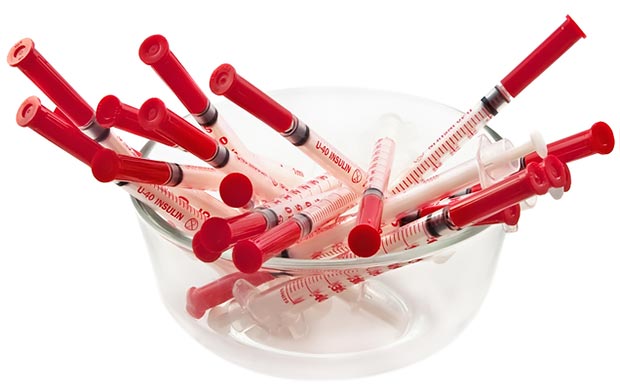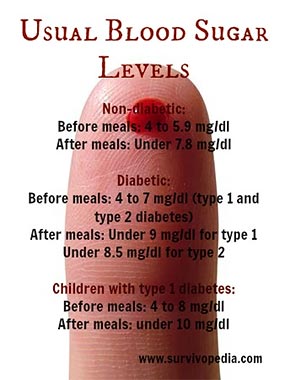| Online: | |
| Visits: | |
| Stories: |
Surviving with Diabetes after SHTF
 Coping with diabetes is hard under normal circumstances. Diabetics need to take regular medication; they must stick to a strict diet and are prone to illness and infection. All of these problems get exacerbated when SHTF. If a disaster happens, a diabetic is left much more vulnerable than the average person. He must take special precautions in order to ensure that he is fit to handle the situation.
Coping with diabetes is hard under normal circumstances. Diabetics need to take regular medication; they must stick to a strict diet and are prone to illness and infection. All of these problems get exacerbated when SHTF. If a disaster happens, a diabetic is left much more vulnerable than the average person. He must take special precautions in order to ensure that he is fit to handle the situation.
After an SHTF event, people with diabetes need to attend to their special medical needs. If they are lucky, they still have access to medical help soon after the disaster strikes. This is not always the case, however, but, if it is, they need to be prepared. They might not be able to communicate with the healthcare professionals due to injury or shock.
Furthermore, the people treating them might not have access to their medical history. That is why they must identify themselves as diabetics so they can receive the proper care. Therefore, the first important guideline for someone with diabetes is to always wear a medical bracelet which provides valuable information regarding their situation.
Preparation Is Key
Oftentimes when SHTF, help is not immediately available. In fact, on many occasions, it can be days or even weeks until you would be able to reach a hospital or any other kind of medical facility. A diabetic simply cannot wait this long without proper medication.
That is why it is highly recommended to create a diabetes disaster kit. It should be easy to carry around, waterproof and insulated so that it does not get damaged. It should also be placed in an area which you can easily access, even after an earthquake, tornado or flood.
There are several items which should be part of this kit:
- Medication and medical supplies. This is the most important resource for a diabetic in an SHTF situation. You should pack as many medical supplies as you have access to since you can never know when you will have access to outside help. A 30-day pack would be ideal. If this is not possible, make sure that the medicine will last you at least 2 or 3 days. The supplies should include insulin, insulin pumps, syringes, glucagon, testing strips, glucose tablets, glucose meters, extra batteries and anything else that you use on a regular basis to treat your diabetes.
- Extra supply of drinking water. Again, it is a good idea to store a lot of water around the home since it becomes a valuable commodity when SHTF. However, keep the water in the disaster kit to about 2 or 3 days worth. Any more and the kit would become cumbersome and difficult to handle.
- A few days worth of food. Besides medication and water, food is extremely important to a diabetic as they need to stick to a specific diet. That is why the food kept in the disaster kit should have two qualities: be nonperishable and be safe for a diabetic.
- Copies of your health records and medical history. In addition to these, you should also keep a list detailing all the medications you are currently taking plus the diet you are on.
- Contact information for family, friends and physician.
When talking about something as dangerous as diabetes, there is no such thing as being overprepared. That is why it is a good idea to keep vital extra supplies such as medication and snacks around other places you regularly visit such as your workplace, homes of friends and family, your neighbors etc.
Insulin is the most important medication for any diabetic so you need to look after it properly. It does not matter how many vials of insulin you have in an emergency if they have not been preserved in an adequate manner.
The good news with insulin is that it does not need to be refrigerated. It can safely be stored at room temperature for as long as a month, as long as that temperature does not exceed 84 degrees Fahrenheit. However, in many areas, the temperature will routinely pass that limit. That is why it is also a good idea to have a cooler to keep your emergency supply of insulin in.
Adding to the disaster kit would be several packets of re-freezing gel in order to maintain proper storage for the insulin even if the electricity goes out.
How to Spot Hypoglycemia
The biggest emergency that a diabetic has to deal with is when blood sugar levels are too high or too low. For a diabetic on insulin, it is important to monitor blood sugar levels at all time in order to make sure that they do not dip below recommended levels.

When this happens, there is a huge risk of suffering from hypoglycemia, a problem which can occur in both Type 1 and Type 2 diabetics. It is most often brought on by missing meals or medications at regular intervals, two scenarios which are very possible when SHTF.
The standard threshold for hypoglycemia is 70 mg/dl, although the actual limit differs from person to person. Even so, knowing and detecting the symptoms of hypoglycemia early on can give you enough time to take the necessary precautions.
The symptoms include dizziness, sweating, shakiness, hunger, fatigue, confusion, an erratic heartbeat and even loss of consciousness. The best course of action if you feel any of these symptoms is to take something that raises blood sugar levels and acts fast. Recommendation would include glucose tablets or natural juice.
Dealing without Medication
By their very nature, SHTF scenarios are unexpected. It is quite possible that you get caught in one such emergency without the medication you require or with lower levels than needed. It is important to know what to do when your insulin is in short supply.
Basically, you will need to stretch out your supply as long as possible in order to wait it out before help arrives. Your diet will play a big factor. Try to avoid eating food rich in carbohydrates and instead go for food full of proteins.
Moreover, you should know who you can contact if the communications lines are up. The Red Cross, the International Diabetes Federation and even the American Embassy can all provide you with an emergency supply of insulin if access is cut off to your regular supplier.
As you can see, having the proper knowledge and the proper guidance can help anyone overcome a SHTF scenario, even someone with diabetes.
Do you fear about living with chronic disease after disaster? Share your thoughts with us using the comment form below.




